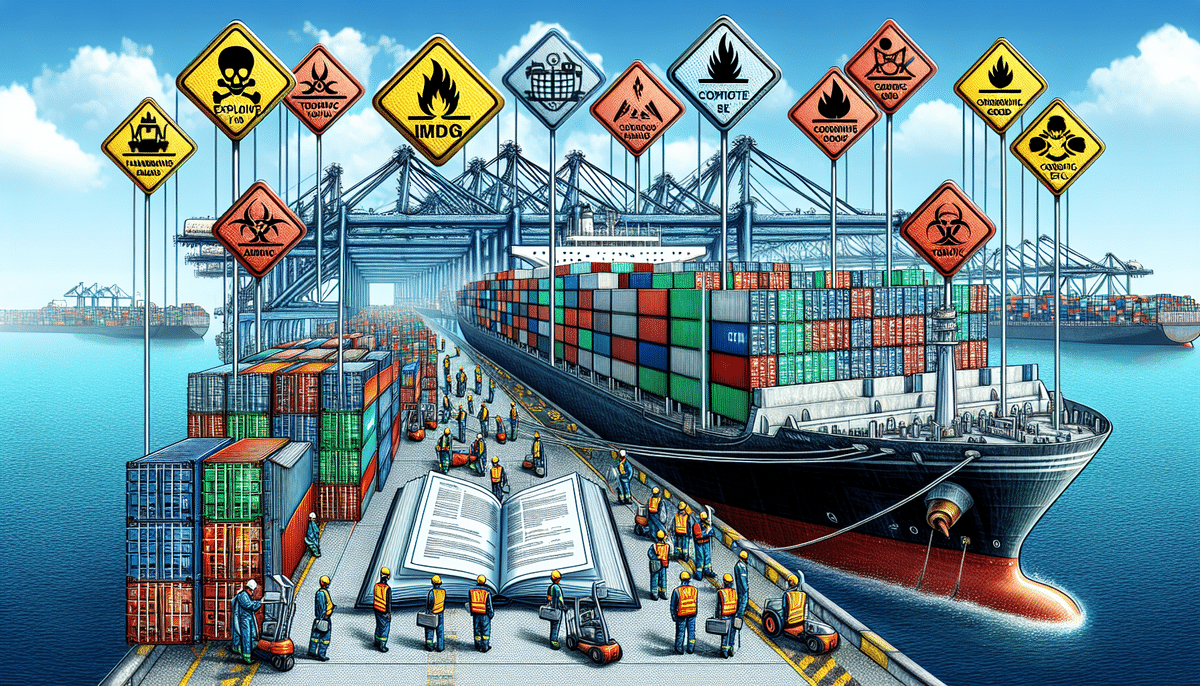Shipping Dangerous Goods with UPS Express Freight
Are you planning to ship dangerous goods? Understanding the regulations, proper packaging, labeling requirements, and best practices for transportation is crucial. In this article, we'll provide a comprehensive guide on shipping dangerous goods with UPS Express Freight. We'll also delve into risk management, customs requirements, and future trends in the transportation of hazardous materials.
Understanding the Regulations for Shipping Dangerous Goods
Compliance with national and international regulations is essential when shipping dangerous goods. Organizations like the International Air Transport Association (IATA) and the International Maritime Dangerous Goods (IMDG) Code set specific requirements for various hazardous items, including flammable liquids, gases, corrosives, explosives, and toxic substances.
Before shipping hazardous materials, identify the category and obtain a Material Safety Data Sheet (MSDS) to understand the associated health, safety, and environmental hazards. Additionally, be aware of country-specific regulations that may necessitate further compliance.
Non-compliance with these regulations can lead to severe consequences such as hefty fines, legal actions, and potential harm to individuals and the environment. Ensuring proper packaging, labeling, documentation, and employee training are critical steps in adhering to these regulations and facilitating the safe and efficient transport of hazardous materials.
The Importance of Proper Packaging for Dangerous Goods
Proper packaging is paramount in safeguarding both handlers and the environment when transporting dangerous goods. Packaging must be robust enough to endure transportation stresses and prevent leakage. Moreover, it should align with the specific requirements of the dangerous goods category being shipped. For instance, packaging for flammable liquids differs significantly from that of corrosive substances.
If you're uncertain about packaging requirements, consult a hazardous materials expert or refer to the latest guidelines from IATA or the IMDG Code.
Proper labeling is equally important. Labels should clearly indicate the type of dangerous goods, associated hazards, and any special handling instructions. This ensures that all parties involved in the transportation process manage the package correctly, maintaining safety and compliance.
Additionally, training employees who handle dangerous goods is essential. They must be knowledgeable about the hazards, safe handling practices, and emergency procedures to prevent accidents and protect both people and the environment.
Identifying Hazardous Materials and Proper Labeling Requirements
Accurate identification and labeling of hazardous materials are critical for safe transportation. Labels must follow a specific format that conveys the hazards associated with the materials, ensuring that handlers are aware of the potential risks.
Proper labeling includes the shipping name, identification number, hazard class, packing group, and pictograms. Each element provides vital information for the safe handling and compliance with IATA and IMDG regulations.
Labeling requirements may vary based on the mode of transportation. For example, air transportation labeling differs from sea transportation. Understanding these specific regulations is crucial to ensure compliance and safety during transit.
Moreover, comprehensive training on hazardous materials, including handling, storage, and emergency response protocols, is essential for individuals involved in the transportation process. This knowledge ensures the safe and compliant movement of dangerous goods.
Shipping Lithium Batteries: Best Practices and Regulations to Follow
Shipping lithium batteries poses unique challenges due to their inherent safety risks. As dangerous goods, lithium batteries require special handling and compliance with specific regulations. Shipping documents must clearly identify the battery type, number of cells, and watt-hour rating.
Lithium batteries should be securely packed to prevent movement and short-circuiting. Packaging must also adhere to cargo aircraft-only labeling requirements, as per IATA guidelines.
Different countries may have varying regulations regarding lithium battery shipments. Some may prohibit them entirely, while others may impose specific packaging and labeling requirements. It's essential to research and comply with both origin and destination country regulations to ensure a safe and successful shipment.
Understanding the Role of the Shipper, Carrier, and Receiver
Effective transportation of dangerous goods involves clear roles and responsibilities for the shipper, carrier, and receiver:
- Shipper: Responsible for proper packaging, labeling, and ensuring regulatory compliance.
- Carrier: Ensures adherence to regulations and safely transports the shipment.
- Receiver: Responsible for unloading and verifying compliance upon delivery.
Effective communication among all parties is essential to prevent misunderstandings and ensure safety. Staying updated on regulatory changes is also crucial for all involved parties.
In case of incidents or emergencies, having a clear response plan, including necessary equipment and training, is vital. Efficient reporting and communication with authorities are also essential components of a robust emergency response strategy.
How to Choose the Right UPS Express Freight Service for Your Dangerous Goods
UPS Express Freight offers a variety of shipping options tailored for dangerous goods. The appropriate service depends on the type of goods, destination, and delivery urgency. Options include:
- Standard and Deferred Services: Suitable for non-urgent shipments.
- Express and Hand-Carry Services: Ideal for urgent deliveries.
Choosing the right service helps avoid delays, additional costs, and compliance issues. Additionally, consider packaging requirements specific to each service. UPS provides detailed packaging guidelines for various dangerous goods, including lithium batteries and infectious substances, ensuring safe and compliant transportation.
Preparing Your Dangerous Goods Shipment for UPS Express Freight
To prepare your dangerous goods shipment for UPS Express Freight:
- Ensure compliance with packaging, labeling, and documentation requirements.
- Properly pack the shipment to prevent damage during transit.
- Use clear and regulation-compliant labels.
- Accurately complete shipment documents, including the MSDS and any necessary customs documentation.
Be aware that certain dangerous goods may require special handling or additional permits. For example, shipments containing lithium batteries may need extra documentation and labeling. Understanding and adhering to these specific requirements is essential to avoid delays or penalties.
Using a reputable carrier like UPS ensures expertise in handling dangerous goods safely and efficiently, with comprehensive tracking and monitoring throughout the transportation process.
Tips for Safe Handling and Transportation of Dangerous Goods
Ensure the safe handling and transportation of hazardous materials by following these tips:
- Regulatory Compliance: Adhere to all shipping regulations for dangerous goods.
- Accurate Documentation: Verify that all shipment documents are complete and accurate.
- Proper Packaging and Labeling: Ensure all packages are correctly packed and clearly labeled.
- Employee Training: Train and certify personnel responsible for handling dangerous goods.
- Specialized Equipment: Utilize appropriate tools and equipment for handling hazardous materials.
Different types of dangerous goods require specific handling and transportation methods. For instance, flammable liquids must be stored away from heat sources, while corrosive materials need containers resistant to their properties.
Additionally, having a contingency plan for emergencies is crucial. This plan should outline procedures for spills, leaks, and other incidents, and ensure that emergency response equipment like spill kits and fire extinguishers are readily available.
Managing Risk in Shipping Dangerous Goods: Insurance Options to Consider
Despite taking all precautions, shipping dangerous goods inherently carries risks. As a shipper, it's prudent to consider insurance options that cover loss and damage during transportation. UPS offers insurance protection for shipments at an additional cost.
Moreover, consider the financial implications of non-compliance, which can result in significant fines and reputational damage. Insurance coverage helps mitigate some of the financial risks associated with shipping dangerous goods, providing an added layer of protection.
Understanding Customs Requirements for Shipping Dangerous Goods Internationally
International shipping of dangerous goods demands compliance with both local and destination country regulations. Customs authorities may require additional documentation and inspections, potentially causing delays.
To minimize delays:
- Ensure all customs documentation is accurate and meets destination country requirements.
- Work with carriers experienced in international dangerous goods shipping, such as UPS, to navigate customs requirements effectively.
Proper preparation and understanding of international regulations are essential for smooth and compliant shipments.
Common Mistakes to Avoid When Shipping Dangerous Goods with UPS Express Freight
Shipping dangerous goods involves complexities where common mistakes can lead to significant issues. Avoid the following errors:
- Incorrect packaging that doesn't meet regulatory standards.
- Improper labeling that fails to convey necessary hazard information.
- Inaccurate or incomplete documentation that delays shipment processing.
- Non-compliance with national and international regulations, risking fines and shipment rejection.
- Choosing the wrong service type, which can lead to delays and increased costs.
The Future of Shipping Dangerous Goods: Trends and Innovations to Watch Out For
The shipping industry is continually evolving, with several trends and innovations poised to impact the transportation of dangerous goods:
- Advancements in Tracking and Monitoring: Enhanced technologies provide real-time tracking and monitoring of hazardous materials.
- Improved Packaging Materials: Innovations in packaging offer better protection and compliance with evolving regulations.
- Enhanced Supply Chain Management Systems: Systems that increase visibility and ensure regulatory compliance throughout the supply chain.
- Adoption of Automation Technologies: Automation in handling hazardous materials improves efficiency and reduces human error.
Staying abreast of these trends and incorporating relevant innovations can improve the safety, efficiency, and compliance of shipping dangerous goods.
Conclusion
Shipping dangerous goods necessitates meticulous planning, comprehensive knowledge, and strict adherence to regulations. Understanding the regulatory landscape, ensuring proper packaging and labeling, and following best transportation practices are vital for the safe handling of hazardous materials. UPS Express Freight offers a range of services tailored for dangerous goods, emphasizing the importance of selecting the appropriate service, accurately preparing documentation, and correctly packing and labeling shipments. By adhering to these guidelines, you can avoid delays, prevent damage, and minimize costs associated with shipping dangerous goods.




















